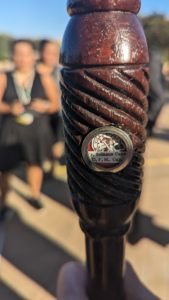By all appearances, newly ordained Auxiliary Bishop Matthew Elshoff, OFM Cap., is getting a second chance at making a first impression.
It’s not just a title change for someone who went by “Father Matt” as president of St. Francis High School, or “Padre Mateo” at his last assignment, St. Lawrence of Brindisi Church in Watts.
Perhaps the most striking change is his new look.
For 40 years, he dressed in the traditional habit of a Capuchin Franciscan, with a dark brown hooded robe tied at the waist by a white rope, large wooden prayer beads at his side, and sandals on his feet. The introductory press conference for LA’s four new auxiliary bishops in July was the first time most of his friends had seen him in a black clerical shirt and a white collar. He later admitted he had trouble recalling the last time he’d worn dress shoes and socks.
That’s what making history looks like for Elshoff, the first religious order priest to serve as bishop in Los Angeles in 35 years, and the first Capuchin bishop in California’s history.

Elshoff will serve as episcopal vicar for the Our Lady of the Angels Pastoral Region, which covers 77 parishes stretching west to east from Malibu to downtown Los Angeles, and as far south as Elshoff’s last neighborhood, Watts.
So what can faithful in the region expect from him?
“We are generally characterized by our simplicity, and this is no less evident in Bishop Matt,” said Father Joseph Seraphin, OFM Cap., regional provincial of the order’s Western American Province of Our Lady of Angels, which Elshoff has belonged to since he joined the order in the 1970s. “Anyone can feel free to approach [Elshoff] and not feel intimidated.”
Seraphin explained that the title “Friar Minor,” or “OFM Capuchin,” identifies one as “a lesser brother.”
“[Elshoff] has been called for the last 50 years of his religious life to exude this minority, this humility, this simplicity,” said Seraphin, who has known Elshoff for 23 years and was most recently his associate pastor at St. Lawrence of Brindisi.
The Capuchins in the region have been most visible in three key locations in Southern California: Old Mission Santa Ines in Solvang, their home base for vocational formation; St. Lawrence Church in Watts, named for the 16th-century Italian Franciscan saint; and St. Francis High School in La Cañada Flintridge, Elshoff’s alma mater.
The Capuchins describe themselves as being both a contemplative and active order. Seraphin said Elshoff “lives both sides of the Capuchin coin well.”
“He is always up early in the morning for personal prayer time with an emphasis on mental prayer moving to contemplation. Bishop Matt is well versed in the spiritual classics as well as Franciscan spirituality, which both serve him in his interior life.”
After the Franciscan Order started in 1223, the Capuchins began as a reform group in 1528 that included converting to the hooded brown habits. The name “cappuccio” means “hood” in Italian. Like the Catholic Church’s most well-known Capuchin, St. Pio of Pietrelcina (or “Padre Pio”), the friars are known for their closeness to people.
“People like to have the confidence to speak with their religious leaders about anything under the sun,” said Seraphin. “Sometimes, people say to us Capuchin friars, ‘I am sorry for taking up your time but…’ This is not a bother because Capuchins are here to be available for the people, especially their faith needs. Our religious invite us to open to people’s needs.”

The Capuchins are one of the largest religious orders of men in the Church with some 12,000 members. There are about 80 Capuchins working in Southern California and Mexico today, according to Father Peter Banks, OFM Cap., who spent more than 40 years as pastor at St. Lawrence before returning to Old Mission Santa Ynez in 2009 to work in vocations.
Banks, originally from Ireland, said Elhoff’s experience in administration and as a certified marriage counselor stands out in an order where members are taught to avoid the spotlight and attention.
“He is at home with this, he has all the right skills to speak the language and fit in very well with the diocesan life and its environment,” said Banks.
“This is not an easy area, but he is gentle by nature and has the right mannerism. He also has the gift of being in the academic world. I wasn’t surprised he was chosen for this role. I told him he was always moving in the right circles to become a bishop.”
Brother Tran Vu, OFM Cap., has known Elshoff for more than 25 years, and the two lived together at St. Francis High from 2003 until 2008, when Elshoff was appointed a provincial.
“I see him as a modern day questor,” said Vu. “Centuries ago, questors were the friars who went house to house looking for food, collecting leftovers for those in need. He is a questor for raising funds for Catholic education. He has the experience and organization skills to connect with a much larger group and address those needs.”
But will these new bishop garments become an identity issue for Elshoff?
“You can take the man out of the habit — and even put on the bishop’s attire — but you can never take the habit out of the man,” said Seraphin. “Bishop Matt will always carry a Franciscan focus in his ministry. He cannot help that. That is who he is. He will continue to preach the Gospel in Capuchin simplicity.”

